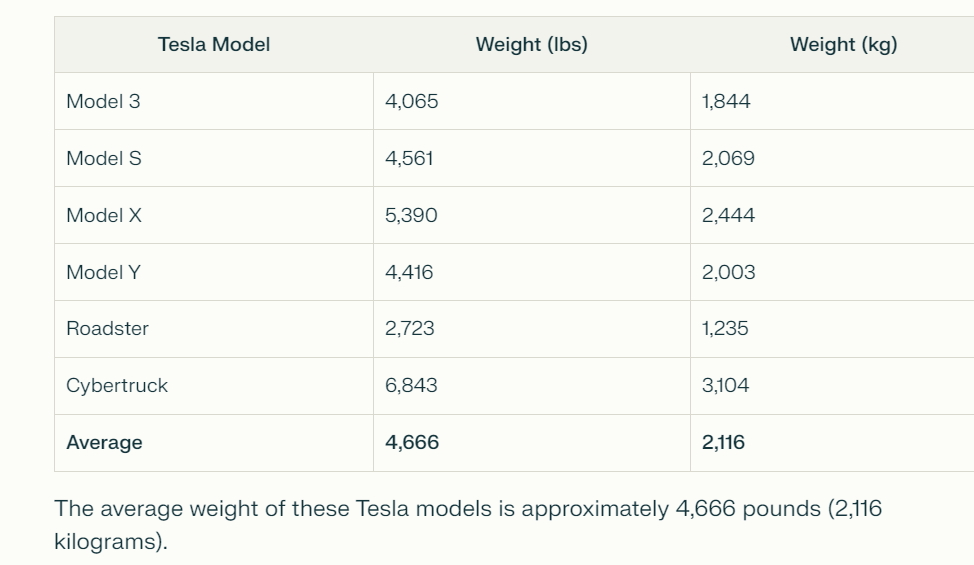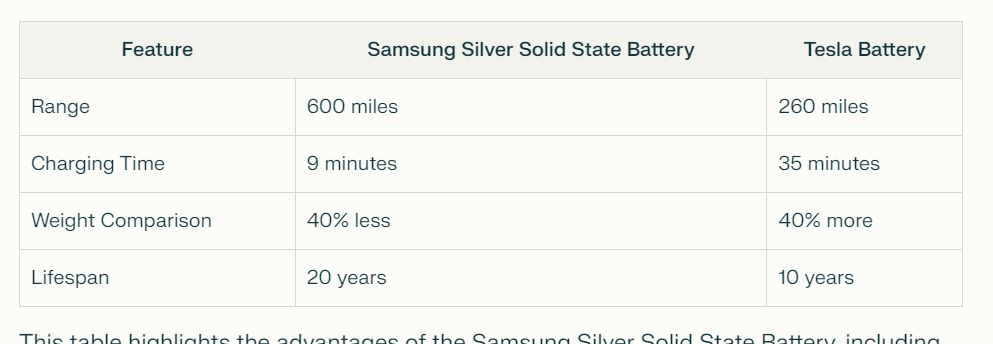Silver vs Lithium-ion: One Metal Wins in a Landslide Across All Key Performance Categories.
The Clear Winner in Customer Satisfaction and Product Performance is Silver.
Silver batteries are also less expensive than Lithium-ion batteries when considering life cycle costs.
Tesla currently sells several models, each with its own battery specifications. Here is a summary of the models and the weight and composition of their batteries:
Tesla Model 3: The battery pack in the Tesla Model 3 weighs approximately 480 kg (1,060 pounds) and can deliver up to 75 kWh of energy. The composition includes lithium, cobalt, and manganese, with about 8 kg of lithium, 14 kg of cobalt, and 20 kg of manganese.
Tesla Model S: The battery pack for the Tesla Model S weighs around 544 kg (1,200 pounds) and delivers up to 100 kWh of energy. It contains approximately 62.6 kg (138 pounds) of lithium.
Tesla Model X: The weight of the battery pack for the Tesla Model X is not explicitly mentioned, but it is known to be one of the heaviest Tesla models overall, with the vehicle's total weight being up to 5,390 pounds. The battery composition is similar to other Tesla models, primarily lithium-ion with components like cobalt and manganese.
Tesla Model Y: Similar to the Model 3, the Model Y's battery pack weighs around 480 kg (1,060 pounds) and shares a similar composition, including lithium, cobalt, and manganese.
Tesla Roadster: The original Tesla Roadster's battery system weighs about 900 pounds. However, specific details about the composition are not provided, but it is likely similar to other Tesla models with lithium-ion technology.
The battery's weight is primarily due to the cells and metals they contain, which make up 60 to 75 percent of the total weight. The remaining weight comes from the battery's metal casing, cables, and management systems.
Then There’s the Hideous Cybertruck
The Cybertruck features a structural battery pack composed of 4680 lithium-ion cells, with a nominal voltage of 816 V and an energy density of 170 Wh/kg. The pack serves as a structural element in the vehicle, contributing to its overall design and performance
Growing Hatred for Tesla
Tesla customers have expressed frustration over several issues, including:
long charging times
reduced vehicle range in cold climates
challenges with resale value.
batteries not making it 10 years
cost of battery replacement
the flood of Tesla inventory
source - https://www.thedrive.com/news/tesla-is-stocking-unsold-brand-new-model-3s-in-an-overgrown-field-in-florida
Many Tesla owners are dissatisfied with the wait times at charging stations, which have been exacerbated by Tesla's decision to open its network to non-Tesla vehicles, potentially increasing congestion.
In cold weather, the performance of Tesla vehicles can suffer as the range decreases significantly, with reports indicating a loss of up to 41% in range at temperatures below 20 degrees Fahrenheit.
Additionally, charging times can increase as the battery requires more time to warm up before charging efficiently. Customers have also been upset by significant price cuts on new Tesla models, which have affected the resale value of their vehicles, leaving some feeling cheated after purchasing at higher prices shortly before the reductions. These issues have contributed to a growing sense of dissatisfaction among Tesla owners.
The Consumer votes with their dollars and will opt for Silver batteries
Lighter in weight
Higher in Energy density (means much better charge, power, torque)
Better in Severe weather
Double the Lifespan
Double the Range
Charges in 10 minutes compared to 35 minutes
Silver should ask you this question, “Is there anything else I can do for you?”
These batteries can provide an impressive 600-mile range on a single charge, which is about double the average range of current electric vehicles. This extended range is crucial for reducing range anxiety among electric vehicle users, making long-distance travel more feasible without frequent recharging stops.
Additionally, silver batteries boast a lifespan of up to 20 years, offering a long-term solution for various transportation needs. This longevity reduces the frequency and cost of battery replacements, making them an economically attractive option over the vehicle's lifetime.
Another standout feature of silver batteries is their rapid charging capability.
They can be fully charged in just nine minutes, a significant improvement over the charging times of traditional lithium-ion batteries. This rapid charging addresses one of the major hurdles in electric vehicle adoption: the inconvenience of long charging times.
Quick turnaround times are essential for applications such as public transportation or logistics, where vehicles need to be back in operation swiftly. The ability to charge quickly without compromising battery performance or lifespan makes silver batteries a compelling choice for industries that require high efficiency and reliability.
High Energy Density is the Key
The high energy density of silver batteries further enhances their performance. With an energy density of 500 Wh/kg, these batteries are nearly twice as dense as current mainstream EV batteries. This high energy density allows for longer travel distances in a smaller, lighter package, which is particularly advantageous for electric trucks and buses that require high efficiency and payload capacity.
Additionally, the use of a solid electrolyte instead of a liquid one reduces the risk of fires, making these batteries safer than traditional options. This safety improvement is crucial for applications in electric ships, ferries, and potentially even military vehicles like tanks, where reliability and safety are paramount.
Overall, the combination of extended range, rapid charging, high energy density, and enhanced safety makes silver batteries a promising technology for the future of electric vehicles and other applications.
Silver is Cheaper than the Lithium Ion battery system when you consider opportunity cost numbers and cost of battery replacement
In my previous professional life, I spent over 15 years in the clay industry (clay-fired masonry, architectural sales)
When it comes to promoting brick, I would have to confidently stand against inferior wall systems such as vinyl, concrete, stucco, and wood and offer a superior alternative.
In some cases, stucco would cost around $5 per square foot, whereas the brick system I was promoting (cavity wall system) would exceed $30 per square foot (it is more now)
Once I had completed the life cycle and factored in other costs, I could demonstrate to architects that you could double the price of our brick and that, because of the brick's physical properties, it would not impact the overall cost of the building project.
(These properties include high density, low absorption, no maintenance, and thermal lag, creating HVAC savings.)
The result is that my sales approach of discussing the quality and maintenance-free aspect almost always wins the approval of architects, engineers, school districts, and city officials. That is why you see that most municipal projects, universities, hospitals, government buildings, and K through 12 schools use brick.
It's better stewardship of public funds.
It's crucial to adopt a long-term perspective when comparing Silver batteries to other systems, just as I did when promoting brick over inferior wall systems.
While the initial cost of brick or silver may be slightly higher, its long-term cost-effectiveness ensures that the overall cost remains stable, providing a secure investment for your building whatever project.









